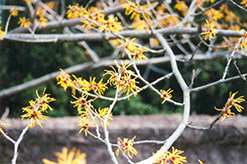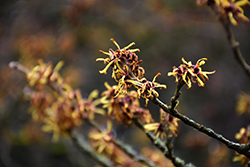It's all about ...
plants

Height: 12 feet
Spread: 12 feet
Sunlight:
![]()
![]()
![]()
Hardiness Zone: 6b
Other Names: Witch Hazel
Description:
A large, spreading shrub which brings color and fragrance to the late winter garden when most other plants are still dormant; fragrant yellow flowers with reddish centers appear along the bare branches, rolling up on cold days, flowers into early spring
Ornamental Features
Chinese Witchhazel features showy fragrant lemon yellow strap-like flowers with red calyces along the branches from late winter to early spring before the leaves. It has green deciduous foliage. The serrated round leaves turn an outstanding yellow in the fall.
Landscape Attributes
Chinese Witchhazel is a dense multi-stemmed deciduous shrub with a ground-hugging habit of growth. Its average texture blends into the landscape, but can be balanced by one or two finer or coarser trees or shrubs for an effective composition.
This shrub will require occasional maintenance and upkeep, and should only be pruned after flowering to avoid removing any of the current season's flowers. Deer don't particularly care for this plant and will usually leave it alone in favor of tastier treats. Gardeners should be aware of the following characteristic(s) that may warrant special consideration;
- Suckering
Chinese Witchhazel is recommended for the following landscape applications;
- Accent
- Mass Planting
- Hedges/Screening
- General Garden Use
Planting & Growing
Chinese Witchhazel will grow to be about 12 feet tall at maturity, with a spread of 12 feet. It tends to fill out right to the ground and therefore doesn't necessarily require facer plants in front, and is suitable for planting under power lines. It grows at a medium rate, and under ideal conditions can be expected to live for 40 years or more.
This shrub performs well in both full sun and full shade. It is quite adaptable, prefering to grow in average to wet conditions, and will even tolerate some standing water. It is not particular as to soil type, but has a definite preference for acidic soils, and is subject to chlorosis (yellowing) of the foliage in alkaline soils. It is somewhat tolerant of urban pollution. This species is not originally from North America.
This plant is not reliably hardy in our region, and certain restrictions may apply; contact the store for more information.

